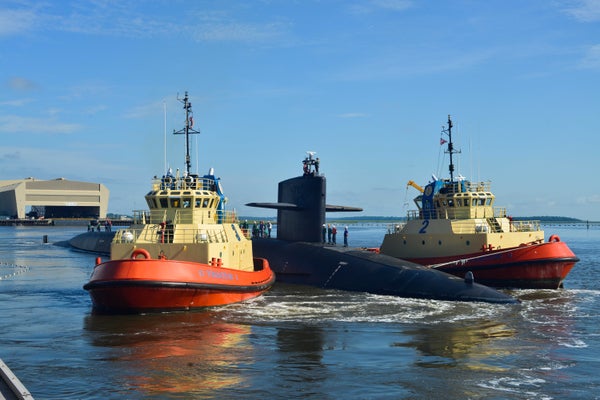CLIMATEWIRE | Flooding, rising seas and extreme heat from climate change threaten the nation’s ability to launch some of its nuclear weapons, according to a new report by the Carnegie Endowment for International Peace.
The report warns that climate change could undermine U.S. efforts to stop adversaries from using nuclear weapons by interfering with the military’s operation and maintenance of missile launch systems that are a key part of nuclear deterrence.
Missile systems at a Navy submarine base in Georgia and at a launch field in North Dakota face increasing flood threats from climate change that could inundate for weeks at a time access roads that are used to transport missiles and maintenance equipment to the sites.
On supporting science journalism
If you're enjoying this article, consider supporting our award-winning journalism by subscribing. By purchasing a subscription you are helping to ensure the future of impactful stories about the discoveries and ideas shaping our world today.
“The issue is really transporting the missiles,” report author and Carnegie fellow Jamie Kwong said in an interview Monday. “If you can't transport the missiles and you have older weapons on board that perhaps need technical updates, that raises questions about the potential viability of missiles.”
At Whiteman Air Force Base in Missouri, heat waves are the major concern. Many climate models predict an increasing number of days with temperatures above 90 degrees Fahrenheit, the threshold for “black flag” days at the air base that limit the activities of armed personnel due to concerns about heat stroke.
“That has implications for pilot readiness,” Kwong said. Whiteman is home to B-2 Spirits, the only U.S. stealth nuclear bombers that are undetectable to enemy radar.
Air-, land- and sea-based weapons systems form the three legs of the U.S. nuclear triad that the Pentagon calls the “backbone of America’s national security.”
“Each leg of the U.S. nuclear triad could be detrimentally affected by climate change,” Kwong said. “We need to recognize and diagnose these climate vulnerabilities now, to make sure that we're adequately prepared to mitigate these risks where possible and adapt where necessary.”
The Pentagon said in a statement to E&E News that it is “taking steps to understand, prepare for, and adapt to climate change while preserving operational capability and protecting key systems. Failing to adapt to climate change would result in lost military capability, weakened alliances, and degraded infrastructure.”
The report is the first to look at the impacts of climate change on the U.S. nuclear deterrent capabilities, Kwong said. To assess the risks, Kwong overlaid the predictions from government climate models such as the NOAA model for sea-level rise with critical nuclear warhead facilities that represent each element of the triad.
“The point of this report is to demonstrate that we're not thinking about this enough,” Kwong said. “One of the most surprising things about my research was how little we're paying attention to this, which is surprising, given the [importance] of nuclear weapons to U.S. national security interests.”
U.S. national security strategy aims to deter adversaries from using nuclear weapons by having enough capability to launch a nuclear strike anywhere and at any time.
At the Kings Bay, Ga., naval base, the access road to the Strategic Weapons Facility Atlantic, where submarines with nuclear warheads get repaired and receive supplies, is projected to flood once a year on average, the report found. The base is one of only two sites equipped to fully support a ballistic missile submarine fleet, one of the most important legs of the U.S. nuclear system for its clandestine operations under the sea.
The launch fields in Minot, N.D., could face similar transportation problems, Kwong said. The access roads connecting about 150 underground missile launch pads are unpaved dirt roads “particularly vulnerable to flooding,” the report says.
Unpassable access roads could disrupt the missile maintenance efforts, a problem with potential “far-reaching consequences” as many U.S nuclear weapons were built during the Cold War and need frequent maintenance to properly function, the report says.
At the Whiteman air base, the average number of days with maximum temperature of 90 F or higher could increase to 84 per year by midcentury and to 114 by 2070 from the current level of 35 days, according to the report.
Heat waves could also impact the stealth bombers because rising temperatures cause air density to drop, making takeoff difficult, the report says. Commercial aircraft comparable to B-2s in size are grounded at 118 F, according to the report.
Radar-absorbing stealth skins of the B-2 bombers are also highly sensitive to heat and humidity, requiring “special, intensive maintenance” during heatwaves.
Kwong said more discussion around climate change and U.S. nuclear capability is crucial in determining how to preserve nuclear deterrence.
Reprinted from E&E News with permission from POLITICO, LLC. Copyright 2023. E&E News provides essential news for energy and environment professionals.
